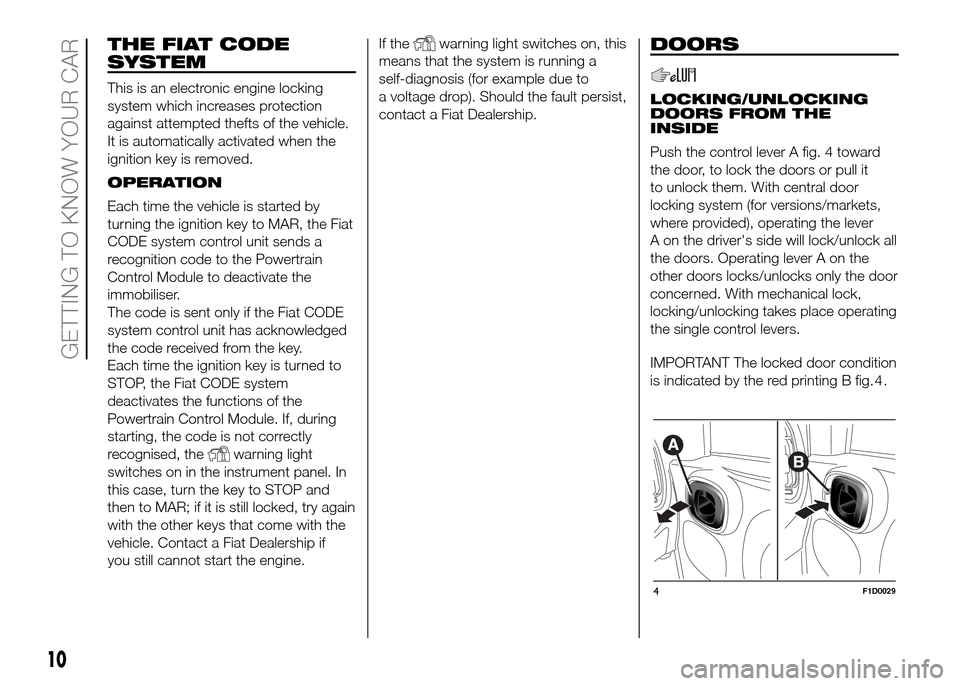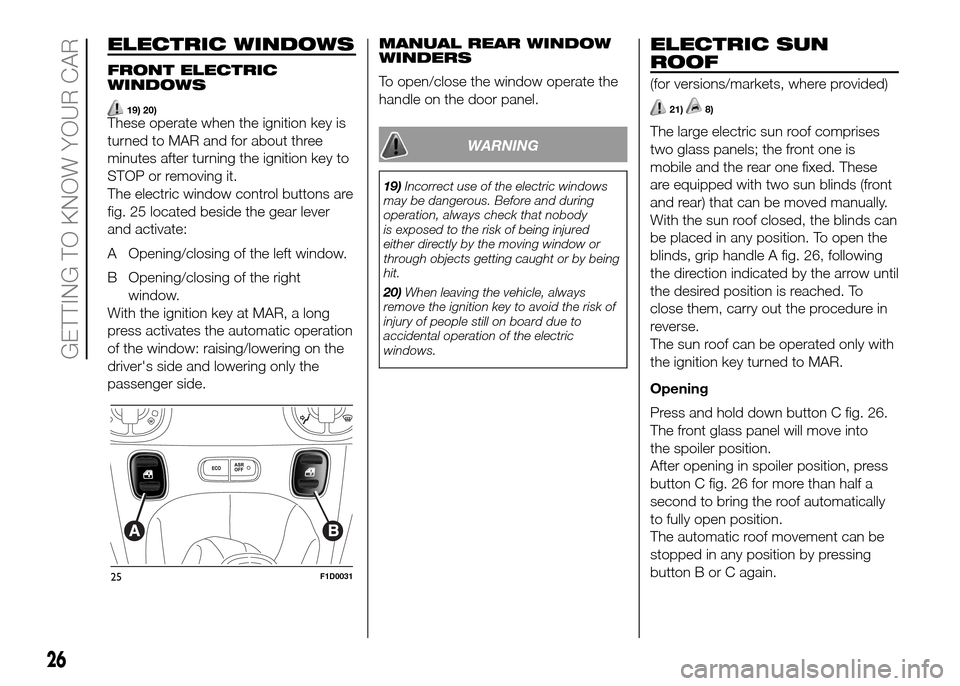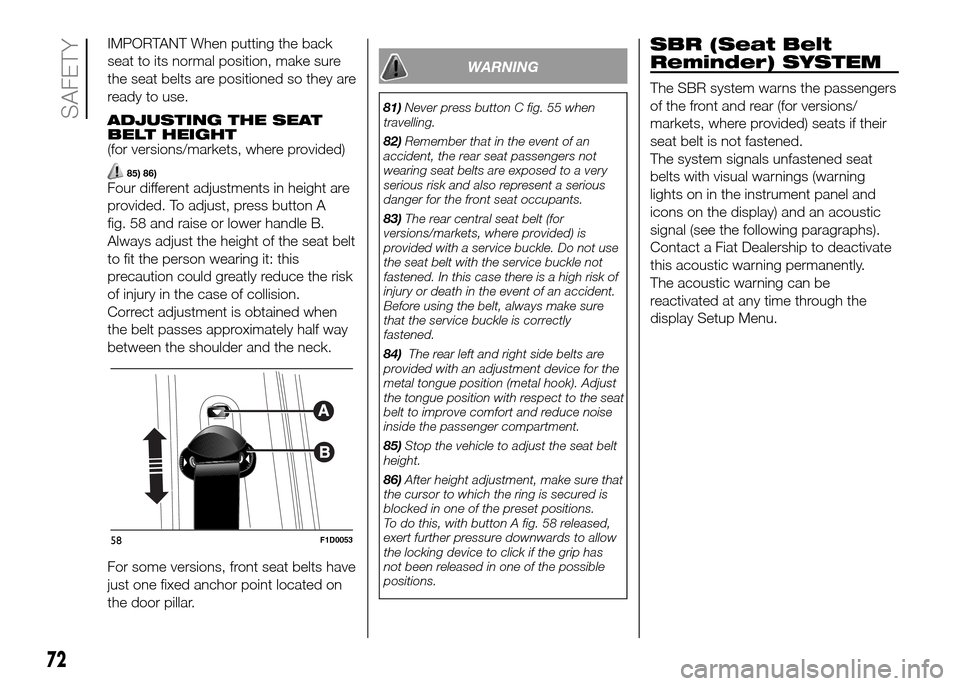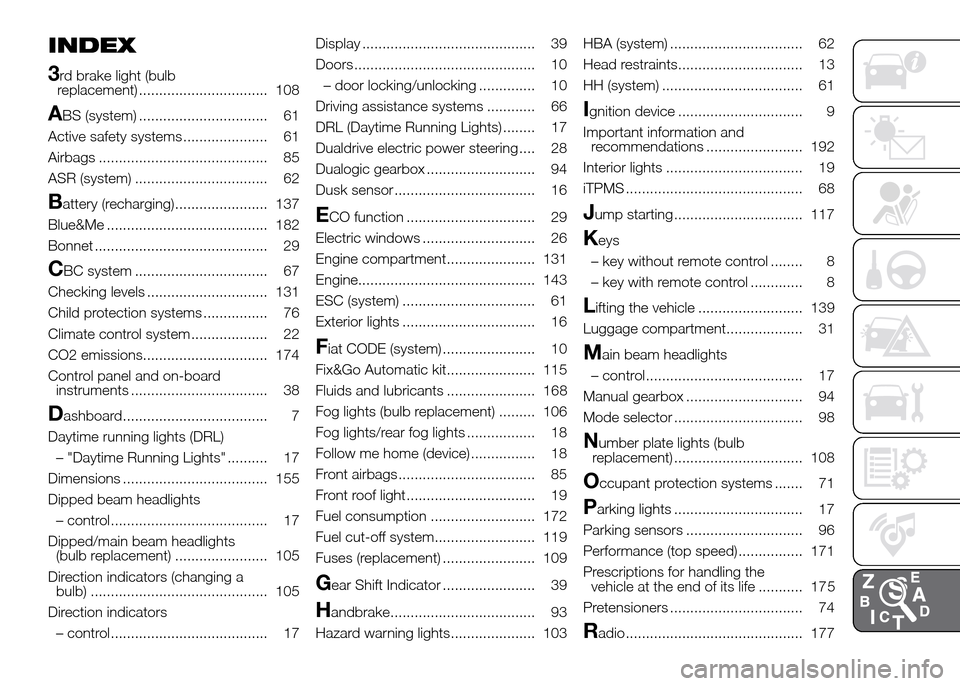Door panel FIAT PANDA 2016 319 / 3.G Owners Manual
[x] Cancel search | Manufacturer: FIAT, Model Year: 2016, Model line: PANDA, Model: FIAT PANDA 2016 319 / 3.GPages: 204, PDF Size: 18.77 MB
Page 12 of 204

THE FIAT CODE
SYSTEM
This is an electronic engine locking
system which increases protection
against attempted thefts of the vehicle.
It is automatically activated when the
ignition key is removed.
OPERATION
Each time the vehicle is started by
turning the ignition key to MAR, the Fiat
CODE system control unit sends a
recognition code to the Powertrain
Control Module to deactivate the
immobiliser.
The code is sent only if the Fiat CODE
system control unit has acknowledged
the code received from the key.
Each time the ignition key is turned to
STOP, the Fiat CODE system
deactivates the functions of the
Powertrain Control Module. If, during
starting, the code is not correctly
recognised, the
warning light
switches on in the instrument panel. In
this case, turn the key to STOP and
then to MAR; if it is still locked, try again
with the other keys that come with the
vehicle. Contact a Fiat Dealership if
you still cannot start the engine.If the
warning light switches on, this
means that the system is running a
self-diagnosis (for example due to
a voltage drop). Should the fault persist,
contact a Fiat Dealership.DOORS
LOCKING/UNLOCKING
DOORS FROM THE
INSIDE
Push the control lever A fig. 4 toward
the door, to lock the doors or pull it
to unlock them. With central door
locking system (for versions/markets,
where provided), operating the lever
A on the driver's side will lock/unlock all
the doors. Operating lever A on the
other doors locks/unlocks only the door
concerned. With mechanical lock,
locking/unlocking takes place operating
the single control levers.
IMPORTANT The locked door condition
is indicated by the red printing B fig. 4 .
4F1D0029
10
GETTING TO KNOW YOUR CAR
Page 18 of 204

IMPORTANT When the heated rear
window is activated, door mirror
defrosting is activated (for versions/
markets, where provided).
Manual folding
When required, fold the mirrors toward
the vehicle interior.
IMPORTANT When driving, the mirrors
must always be open.
WARNING
15)As the driver's door mirror is curved, it
may slightly alter the perception of
distance.
EXTERIOR LIGHTS
The left stalk fig. 18 controls the
operation of the headlights, side lights,
dipped beam headlights, parking lights,
main beam headlights, direction
indicators, and "Follow me home"
device.
The external lights can only be
switched on when the ignition key is at
MAR.
The instrument panel and the various
dashboard controls will come on with
the external lights.AUTOMATIC LIGHT
CONTROL
(Dusk sensor)
(for versions/markets, where provided)
This infrared LED sensor, located on the
windscreen, detects the variations in
outside brightness depending on the
light sensitivity set with the Setup
Menu: the greater the sensitivity, the
less external light is required to activate
the exterior lights.
Activation
The dusk sensor activates when ring
nut A fig. 18 is turned to
. In this
way the side lights and dipped beam
headlights are activated automatically
according to the external light level.
Following automatic light activation, the
fog lights (for versions/markets, where
provided) and rear fog light may still
be switched on. When the lights are
automatically switched off, the front and
rear fog lights (if activated) are also
switched off. The next time the lights
are switched on automatically, the
fog lights must be reactivated manually
(if required).
With dusk sensor active, it is not
possible to keep the main beam
headlights on constantly; only flashing
is permitted. To switch these lights
on constantly, turn ring nut A to
and
pull the stalk towards the steering
wheel.
18F1D0019
16
GETTING TO KNOW YOUR CAR
Page 28 of 204

ELECTRIC WINDOWS
FRONT ELECTRIC
WINDOWS
19) 20)These operate when the ignition key is
turned to MAR and for about three
minutes after turning the ignition key to
STOP or removing it.
The electric window control buttons are
fig. 25 located beside the gear lever
and activate:
A Opening/closing of the left window.
B Opening/closing of the right
window.
With the ignition key at MAR, a long
press activates the automatic operation
of the window: raising/lowering on the
driver's side and lowering only the
passenger side.MANUAL REAR WINDOW
WINDERS
To open/close the window operate the
handle on the door panel.
WARNING
19)Incorrect use of the electric windows
may be dangerous. Before and during
operation, always check that nobody
is exposed to the risk of being injured
either directly by the moving window or
through objects getting caught or by being
hit.
20)When leaving the vehicle, always
remove the ignition key to avoid the risk of
injury of people still on board due to
accidental operation of the electric
windows.
ELECTRIC SUN
ROOF
(for versions/markets, where provided)
21)8)
The large electric sun roof comprises
two glass panels; the front one is
mobile and the rear one fixed. These
are equipped with two sun blinds (front
and rear) that can be moved manually.
With the sun roof closed, the blinds can
be placed in any position. To open the
blinds, grip handle A fig. 26, following
the direction indicated by the arrow until
the desired position is reached. To
close them, carry out the procedure in
reverse.
The sun roof can be operated only with
the ignition key turned to MAR.
Opening
Press and hold down button C fig. 26.
The front glass panel will move into
the spoiler position.
After opening in spoiler position, press
button C fig. 26 for more than half a
second to bring the roof automatically
to fully open position.
The automatic roof movement can be
stopped in any position by pressing
button B or C again.
25F1D0031
26
GETTING TO KNOW YOUR CAR
Page 74 of 204

IMPORTANT When putting the back
seat to its normal position, make sure
the seat belts are positioned so they are
ready to use.
ADJUSTING THE SEAT
BELT HEIGHT
(for versions/markets, where provided)
85) 86)
Four different adjustments in height are
provided. To adjust, press button A
fig. 58 and raise or lower handle B.
Always adjust the height of the seat belt
to fit the person wearing it: this
precaution could greatly reduce the risk
of injury in the case of collision.
Correct adjustment is obtained when
the belt passes approximately half way
between the shoulder and the neck.
For some versions, front seat belts have
just one fixed anchor point located on
the door pillar.
WARNING
81)Never press button C fig. 55 when
travelling.
82)Remember that in the event of an
accident, the rear seat passengers not
wearing seat belts are exposed to a very
serious risk and also represent a serious
danger for the front seat occupants.
83)The rear central seat belt (for
versions/markets, where provided) is
provided with a service buckle. Do not use
the seat belt with the service buckle not
fastened. In this case there is a high risk of
injury or death in the event of an accident.
Before using the belt, always make sure
that the service buckle is correctly
fastened.
84)The rear left and right side belts are
provided with an adjustment device for the
metal tongue position (metal hook). Adjust
the tongue position with respect to the seat
belt to improve comfort and reduce noise
inside the passenger compartment.
85)Stop the vehicle to adjust the seat belt
height.
86)After height adjustment, make sure that
the cursor to which the ring is secured is
blocked in one of the preset positions.
To do this, with button A fig. 58 released,
exert further pressure downwards to allow
the locking device to click if the grip has
not been released in one of the possible
positions.
SBR (Seat Belt
Reminder) SYSTEM
The SBR system warns the passengers
of the front and rear (for versions/
markets, where provided) seats if their
seat belt is not fastened.
The system signals unfastened seat
belts with visual warnings (warning
lights on in the instrument panel and
icons on the display) and an acoustic
signal (see the following paragraphs).
Contact a Fiat Dealership to deactivate
this acoustic warning permanently.
The acoustic warning can be
reactivated at any time through the
display Setup Menu.
58F1D0053
72
SAFETY
Page 94 of 204

STARTING THE
ENGINE
118) 119)
36) 37) 38) 39)
Before starting the engine, adjust the
seat, the interior rear view mirrors,
the door mirrors and fasten the seat
belt correctly.
Never press the accelerator pedal for
starting the engine.
VERSIONS WITH MANUAL
GEARBOX
Petrol versions
Proceed as follows:
❒engage the handbrake and place the
gear lever in neutral.For 0.9 TwinAir
and 0.9 TwinAir Turbo versions
engage the handbrake and place the
gear lever in neutral or fully press the
clutch pedal if a gear other than neutral
is engaged;
❒for all versions (except 0.9
TwinAir Turbo)fully depress the clutch
pedal, without pressing the accelerator;
❒turn the ignition key to AVV and
release it as soon as the engine starts.
Diesel versions
Proceed as follows:
❒engage the handbrake, put the gear
lever into neutral and turn the ignition
key to MAR: the warning lights
andon the instrument panel
will turn on;❒wait for the warning lights
and
to turn off and then fully depress
the clutch pedal without pressing the
accelerator;
❒turn the ignition key to AVV as soon
as warning light
switches off.
Release the ignition key as soon as the
engine starts.
IMPORTANT If the engine does not
start at the first attempt, return the
ignition key to STOP before repeating
the procedure. If, with the ignition
key at MAR, the warning lights
and
(only for petrol versions) stay on
in the instrument panel, the ignition key
must be brought back to STOP and
then to MAR again. If the
warning
light stays on, retry with the other
keys provided. Contact a Fiat
Dealership if you still cannot start the
engine.
VERSIONS WITH
DUALOGIC GEARBOX
120)Engine starting is allowed both with a
gear engaged and with the gearbox
in neutral (N).
However, the brake pedal must always
be pressed first if neutral is not
engaged. It is therefore advisable to
place the gear lever in neutral (N) before
starting the engine.LPG AND NATURAL
POWER VERSIONS
The engine always starts up on petrol
independently of the mode previously
selected.
40)
STOPPING THE ENGINE
41)Turn the ignition key to STOP while the
engine is idling.
IMPORTANT After a demanding drive,
before turning the engine off you should
allow it to idle to allow the temperature
in the engine compartment to
decrease.
92
STARTING AND DRIVING
WARNING
118)It is dangerous to run the engine in
enclosed areas. The engine takes in
oxygen and releases carbon dioxide,
carbon monoxide and other toxic gases.
119)Remember that the brake servo
and power steering are not operational until
the engine has been started, therefore
you need to apply much more force than
usual to the brake pedal and steering
wheel.
120)If the engine fails to start with a gear
engaged, the potentially dangerous
situation due to the fact that the gearbox is
automatically placed in neutral will be
signalled by an acoustic signal.
Page 201 of 204

INDEX
3
rd brake light (bulb
replacement) ................................ 108
ABS (system) ................................ 61
Active safety systems ..................... 61
Airbags .......................................... 85
ASR (system) ................................. 62
Battery (recharging)....................... 137
Blue&Me ........................................ 182
Bonnet ........................................... 29
CBC system ................................. 67
Checking levels .............................. 131
Child protection systems ................ 76
Climate control system ................... 22
CO2 emissions............................... 174
Control panel and on-board
instruments .................................. 38
Dashboard.................................... 7
Daytime running lights (DRL)
– "Daytime Running Lights" .......... 17
Dimensions .................................... 155
Dipped beam headlights
– control....................................... 17
Dipped/main beam headlights
(bulb replacement) ....................... 105
Direction indicators (changing a
bulb) ............................................ 105
Direction indicators
– control....................................... 17Display ........................................... 39
Doors ............................................. 10
– door locking/unlocking .............. 10
Driving assistance systems ............ 66
DRL (Daytime Running Lights) ........ 17
Dualdrive electric power steering .... 28
Dualogic gearbox ........................... 94
Dusk sensor ................................... 16
ECO function ................................ 29
Electric windows ............................ 26
Engine compartment...................... 131
Engine............................................ 143
ESC (system) ................................. 61
Exterior lights ................................. 16
Fiat CODE (system) ....................... 10
Fix&Go Automatic kit...................... 115
Fluids and lubricants ...................... 1
Fog lights (bulb replacement) ......... 106
Fog lights/rear fog lights ................. 18
Follow me home (device) ................ 18
Front airbags .................................. 85
Front roof light ................................ 19
Fuel consumption .......................... 172
Fuel cut-off system......................... 119
Fuses (replacement) ....................... 109
Gear Shift Indicator ....................... 39
Handbrake.................................... 93
Hazard warning lights..................... 103HBA (system) ................................. 62
Head restraints............................... 13
HH (system) ................................... 61
Ignition device ............................... 9
Important information and
recommendations ........................ 19
Interior lights .................................. 19
iTPMS ............................................ 68
Jump starting ................................ 117
Keys
– key without remote control ........ 8
– key with remote control ............. 8
Lifting the vehicle .......................... 139
Luggage compartment................... 31
Main beam headlights
– control....................................... 17
Manual gearbox ............................. 94
Mode selector ................................ 98
Number plate lights (bulb
replacement) ................................ 108
Occupant protection systems ....... 71
Parking lights ................................ 17
Parking sensors ............................. 96
Performance (top speed) ................ 17
Prescriptions for handling the
vehicle at the end of its life ........... 17 5
Pretensioners ................................. 74
Radio ............................................ 1
682
1
77